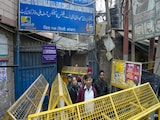Siddharth Mazumdar is a policy analyst and Member, Citizens for Accountable Governance .
"You will not regret voting for the Congress party" declared Prime Minster Manmohan Singh while addressing a rally of 600-700 people in Aizawl two weeks ago. He was in the hilly capital of Mizoram to seek votes for the legislative elections in the state. Expectedly he praised the work of incumbent Congress Chief Minister Laltanhawla but chose not to speak on how during the past decade he slept over a golden chance to fundamentally transform India's seven sisters.
Most economists are now in agreement that since 2003, there has been an unprecedented economic boom in several world economies including ours. Rapid economic gains offer governments a realistic chance to resolve all internal and external conflicts. A recent study by Sweden's Uppsala University has shown that between 2002 and 2012, the world saw far fewer and less severe civil conflicts than any other preceding decade since World War 2. Sri Lanka, Nepal, Myanmar, Burundi and Russia are some examples given in the study where economic growth has led to prosperity and even considerable peace.
Occupying over 8% of India's geographical area and strategically nestled between four countries - Bhutan, Myanmar, Bangladesh, China - India's North East has long borne the brunt of New Delhi's administrative neglect and embroiled in a constant state of insurgency. Unlike other regions in India, the extremely pluralistic North East is not united by a common cultural identity - a common misperception of 'mainlanders' -but neglect and contempt by other fellow Indians.
Historically there have been several explanations for this sustained neglect. Cumulatively all the north eastern states send fewer MP's to the Lok Sabha than the entire state of Orissa. Consequently Delhi based leaders have never expected a significant political dividend from the region. Central government officials routinely complain how hostile neighbors and a difficult terrain adds complexity to policy formulation and implementation in this region.
The last decade presented Prime Minister Manmohan Singh several opportunities - to address historical imbalances in the North East - which were unavailable to most of his predecessors. Unfortunately the Prime Minster chose to look the other way, just like how he did during Coal-gate and the 2G scam. Albeit the year 2004 could have marked a turning point for India's seven sisters when a MP from the region took oath as India's Prime Minster. Ironically till 2004 the only high ranking public position - at a national level - occupied by anyone from the North East has been the position of the Lok Sabha Speaker, by Purno Sangma between 1996 and 1998.
DIPLOMACY THAT COULD HAVE BOUGHT NORMALCY
For most of the independence period, the North East has been at the confluence of an insurgent ridden Myanmar, ethnically tense Tibet and an ISI tilted Bangladesh. But the last ten years witnessed a slew of favorable geopolitical events in each of these countries which if harnessed properly would have firmly put the North East on a high growth trajectory through movement of goods, capital and people. Curiously while India's trade with Bangladesh, China and Myanmar has seen double digit growth under UPA 1 and 2, very little of that has benefited the North East.
The recent political reforms in Myanmar was an opportunity for the Central government to ensure that some of the global attention which Naypyidaw got could have a spillover effect on India's North East. A democratic Myanmar also closes India's "missing land link" with the ASEAN. While under Dr Singh's regime Indo-Myanmar trade has crossed the USD $1.5 billion mark, surface trade account for less than 2% and has been actually declining in the past ten years. Strangely, 99% of this miniscule surface trade happens only though one border check post in Manipur even though the North East shares a 1600 km long border with Burma. On the other hand China has profited from a more peaceful Myanmar. As of 2013, China overtook Thailand to corner three fourths of all surface trade with Myanmar.
While the UPA government is entitled to the claim that under its watch regimes in Bangladesh have been more predisposed towards India, it's not able explain the sharp spike in illegal immigration emanating from that country. Neither the North East has been able to take any benefit from a near triple jump in trade with Bangladesh and China over the past ten years though it shares an extensive land border with the both the countries.
A 2010 agreement on constructing a transit corridor to link North East to rest of India via Bangladesh and access to Bangladesh ports was signed but is yet to see any further steps towards implementation. Of the 33 land custom stations sanctioned along the Bangladesh border only 18 are functional. Similarly there is only one land custom station at NathuLa, Sikkim to facilitate surface trade with China. Hence it is not a surprise that when India managed to export a record $254.4 billion of goods and services last year, the North East's contribution was only $0.01 billion.
A friendly regime in Dhaka and Naypyidaw was a powerful tool for the Center to curb extremism in the North East as well. Unfortunately the 1998 peace process launched by the then Central government with the Naga rebels is yet to reach fruition even today. Extremists in Manipur still manage to shut down large parts of the state by brandishing their rifles as Central forces helplessly look on. Such is the hold of the Manipur insurgents over the border districts that mobile phones, Korean movies, electronic appliances, guns and narcotics are illegally smuggled as far from China via the Burmese border. The large volume of underground trade demonstrates the potential demand which is not being addressed by the government through proactive policies.
GROWTH THAT BY-PASSED THE NORTH EAST
The past nine years have truly been phenomenal for the India growth story. Poverty has seen a sharp decline and economic growth rates have been the highest ever since independence. However for India's North East this phase of economic resurgence wasn't a case where a rising tide lifts all boats. Estimates from the Planning Commission show that poverty has actually increased in all North Eastern states barring Tripura and Arunachal Pradesh between 2004 and 2010. In the same period, industrial growth rate of all north eastern states stood at 3.94% compared to the national average of 10.42%. Between 2001 and 2011, of the 18 new million plus urban conglomerations the country has added, none have come from the North East.
Even in the UPA's flagship employment guarantee scheme several North Eastern states perform much worse than national average. Curiously while the North East ranks high in social development and availability of natural resources, the region has been facing an acute job crisis. According to a report by Price Waterhouse Coopers as per current trends, between 2011 and 2022, there will be 17 million job seekers in the North East but only 2.6 million jobs.
The last census also confirms this disturbing trend. Between the two censuses - Mizoram, Nagaland and Sikkim added much fewer jobs than any other state. A jobless growth in the North East came at a time, when the entire country reaped the benefits of an unprecedented service led economic revolution. It is still baffling as to why a region where English speaking is natural to its population, would remain disconnected from a service sector boom. Not surprisingly it is the people from North East who remain sought after at BPO's in Bangalore and Gurgaon.
PROSPERITY IS STILL AT ARM'S LENGTH
Political stability is very often termed as a necessary condition for prosperity. By this yard stick, the North Eastern states should have been the most prosperous in the country. Of the eight Chief Minster's in the region, four have been in office for more than 10 years. But last year's Kokhrajhar riots were the worst the region has seen in over three decades. The violence triggered off an exodus of North Eastern people from all parts of the country which many sociologists classify as the worst instance of internal displacement in Independent India.
The North's East plight has been paucity of political will rather than funds. Paradoxically at a time when the Union Ministry for the Development of North Eastern Region ( DONER ) is sitting on close to Rs 10,000 crore in the Non-Lapsable Central Pool of Resources ( NLCPR)- a special cess where unspent public funds are transferred for the development of the North East - the Manmohan Singh Government has left the responsibility to someone of the minister of state rank.
Developing hilly and politically difficult terrains is not an impossible feat. Taiwan and South Korea have successfully transformed into Asian miracles. Very rarely in modern history there have been 'islands of underdevelopment'. India's North East-surrounded by rapidly developing economies - is one such exception. In the last nine and half year our Prime Minster had an opportunity to make history but as usual he chose to keep an 'arm's length'.
Disclaimer: The opinions expressed within this blog are the personal opinions of the author. NDTV is not responsible for the accuracy, completeness, suitability, or validity of any information on this blog. All information is provided on an as-is basis. The information, facts or opinions appearing on the blog do not reflect the views of NDTV and NDTV does not assume any responsibility or liability for the same.
"You will not regret voting for the Congress party" declared Prime Minster Manmohan Singh while addressing a rally of 600-700 people in Aizawl two weeks ago. He was in the hilly capital of Mizoram to seek votes for the legislative elections in the state. Expectedly he praised the work of incumbent Congress Chief Minister Laltanhawla but chose not to speak on how during the past decade he slept over a golden chance to fundamentally transform India's seven sisters.
Most economists are now in agreement that since 2003, there has been an unprecedented economic boom in several world economies including ours. Rapid economic gains offer governments a realistic chance to resolve all internal and external conflicts. A recent study by Sweden's Uppsala University has shown that between 2002 and 2012, the world saw far fewer and less severe civil conflicts than any other preceding decade since World War 2. Sri Lanka, Nepal, Myanmar, Burundi and Russia are some examples given in the study where economic growth has led to prosperity and even considerable peace.
Occupying over 8% of India's geographical area and strategically nestled between four countries - Bhutan, Myanmar, Bangladesh, China - India's North East has long borne the brunt of New Delhi's administrative neglect and embroiled in a constant state of insurgency. Unlike other regions in India, the extremely pluralistic North East is not united by a common cultural identity - a common misperception of 'mainlanders' -but neglect and contempt by other fellow Indians.
Historically there have been several explanations for this sustained neglect. Cumulatively all the north eastern states send fewer MP's to the Lok Sabha than the entire state of Orissa. Consequently Delhi based leaders have never expected a significant political dividend from the region. Central government officials routinely complain how hostile neighbors and a difficult terrain adds complexity to policy formulation and implementation in this region.
The last decade presented Prime Minister Manmohan Singh several opportunities - to address historical imbalances in the North East - which were unavailable to most of his predecessors. Unfortunately the Prime Minster chose to look the other way, just like how he did during Coal-gate and the 2G scam. Albeit the year 2004 could have marked a turning point for India's seven sisters when a MP from the region took oath as India's Prime Minster. Ironically till 2004 the only high ranking public position - at a national level - occupied by anyone from the North East has been the position of the Lok Sabha Speaker, by Purno Sangma between 1996 and 1998.
DIPLOMACY THAT COULD HAVE BOUGHT NORMALCY
For most of the independence period, the North East has been at the confluence of an insurgent ridden Myanmar, ethnically tense Tibet and an ISI tilted Bangladesh. But the last ten years witnessed a slew of favorable geopolitical events in each of these countries which if harnessed properly would have firmly put the North East on a high growth trajectory through movement of goods, capital and people. Curiously while India's trade with Bangladesh, China and Myanmar has seen double digit growth under UPA 1 and 2, very little of that has benefited the North East.
The recent political reforms in Myanmar was an opportunity for the Central government to ensure that some of the global attention which Naypyidaw got could have a spillover effect on India's North East. A democratic Myanmar also closes India's "missing land link" with the ASEAN. While under Dr Singh's regime Indo-Myanmar trade has crossed the USD $1.5 billion mark, surface trade account for less than 2% and has been actually declining in the past ten years. Strangely, 99% of this miniscule surface trade happens only though one border check post in Manipur even though the North East shares a 1600 km long border with Burma. On the other hand China has profited from a more peaceful Myanmar. As of 2013, China overtook Thailand to corner three fourths of all surface trade with Myanmar.
While the UPA government is entitled to the claim that under its watch regimes in Bangladesh have been more predisposed towards India, it's not able explain the sharp spike in illegal immigration emanating from that country. Neither the North East has been able to take any benefit from a near triple jump in trade with Bangladesh and China over the past ten years though it shares an extensive land border with the both the countries.
A 2010 agreement on constructing a transit corridor to link North East to rest of India via Bangladesh and access to Bangladesh ports was signed but is yet to see any further steps towards implementation. Of the 33 land custom stations sanctioned along the Bangladesh border only 18 are functional. Similarly there is only one land custom station at NathuLa, Sikkim to facilitate surface trade with China. Hence it is not a surprise that when India managed to export a record $254.4 billion of goods and services last year, the North East's contribution was only $0.01 billion.
A friendly regime in Dhaka and Naypyidaw was a powerful tool for the Center to curb extremism in the North East as well. Unfortunately the 1998 peace process launched by the then Central government with the Naga rebels is yet to reach fruition even today. Extremists in Manipur still manage to shut down large parts of the state by brandishing their rifles as Central forces helplessly look on. Such is the hold of the Manipur insurgents over the border districts that mobile phones, Korean movies, electronic appliances, guns and narcotics are illegally smuggled as far from China via the Burmese border. The large volume of underground trade demonstrates the potential demand which is not being addressed by the government through proactive policies.
GROWTH THAT BY-PASSED THE NORTH EAST
The past nine years have truly been phenomenal for the India growth story. Poverty has seen a sharp decline and economic growth rates have been the highest ever since independence. However for India's North East this phase of economic resurgence wasn't a case where a rising tide lifts all boats. Estimates from the Planning Commission show that poverty has actually increased in all North Eastern states barring Tripura and Arunachal Pradesh between 2004 and 2010. In the same period, industrial growth rate of all north eastern states stood at 3.94% compared to the national average of 10.42%. Between 2001 and 2011, of the 18 new million plus urban conglomerations the country has added, none have come from the North East.
Even in the UPA's flagship employment guarantee scheme several North Eastern states perform much worse than national average. Curiously while the North East ranks high in social development and availability of natural resources, the region has been facing an acute job crisis. According to a report by Price Waterhouse Coopers as per current trends, between 2011 and 2022, there will be 17 million job seekers in the North East but only 2.6 million jobs.
The last census also confirms this disturbing trend. Between the two censuses - Mizoram, Nagaland and Sikkim added much fewer jobs than any other state. A jobless growth in the North East came at a time, when the entire country reaped the benefits of an unprecedented service led economic revolution. It is still baffling as to why a region where English speaking is natural to its population, would remain disconnected from a service sector boom. Not surprisingly it is the people from North East who remain sought after at BPO's in Bangalore and Gurgaon.
PROSPERITY IS STILL AT ARM'S LENGTH
Political stability is very often termed as a necessary condition for prosperity. By this yard stick, the North Eastern states should have been the most prosperous in the country. Of the eight Chief Minster's in the region, four have been in office for more than 10 years. But last year's Kokhrajhar riots were the worst the region has seen in over three decades. The violence triggered off an exodus of North Eastern people from all parts of the country which many sociologists classify as the worst instance of internal displacement in Independent India.
The North's East plight has been paucity of political will rather than funds. Paradoxically at a time when the Union Ministry for the Development of North Eastern Region ( DONER ) is sitting on close to Rs 10,000 crore in the Non-Lapsable Central Pool of Resources ( NLCPR)- a special cess where unspent public funds are transferred for the development of the North East - the Manmohan Singh Government has left the responsibility to someone of the minister of state rank.
Developing hilly and politically difficult terrains is not an impossible feat. Taiwan and South Korea have successfully transformed into Asian miracles. Very rarely in modern history there have been 'islands of underdevelopment'. India's North East-surrounded by rapidly developing economies - is one such exception. In the last nine and half year our Prime Minster had an opportunity to make history but as usual he chose to keep an 'arm's length'.
Disclaimer: The opinions expressed within this blog are the personal opinions of the author. NDTV is not responsible for the accuracy, completeness, suitability, or validity of any information on this blog. All information is provided on an as-is basis. The information, facts or opinions appearing on the blog do not reflect the views of NDTV and NDTV does not assume any responsibility or liability for the same.















